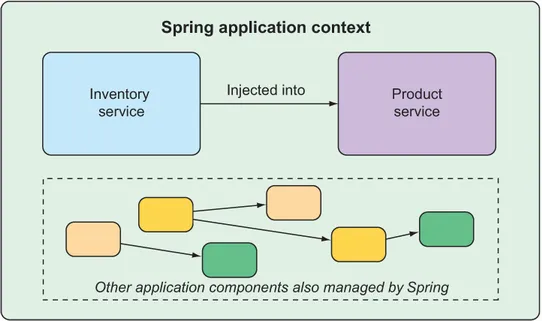
Spring in Action, Sixth Edition
Craig Walls
- 520 páginas
- English
- ePUB (apto para móviles)
- Disponible en iOS y Android
Spring in Action, Sixth Edition
Craig Walls
Información del libro
If you need to learn Spring, look no further than this widely beloved and comprehensive guide! Fully revised for Spring 5.3, and packed with interesting real-world examples to get your hands dirty with Spring. In Spring in Action, 6th Edition you will learn: Building reactive applications
Relational and NoSQL databases
Integrating via HTTP and REST-based services, and sand reactive RSocket services
Reactive programming techniques
Deploying applications to traditional servers and containers
Securing applications with Spring Security Over the years, Spring in Action has helped tens of thousands of developers get a major productivity boost from Spring. This new edition of the classic bestseller covers all of the new features of Spring 5.3 and Spring Boot 2.4 along with examples of reactive programming, Spring Security for REST Services, and bringing reactivity to your databases. You'll also find the latest Spring best practices, including Spring Boot for application setup and configuration. About the technology
Spring is required knowledge for Java developers! Why? Th is powerful framework eliminates a lot of the tedious configuration and repetitive coding tasks, making it easy to build enterprise-ready, production-quality software. The latest updates bring huge productivity boosts to microservices, reactive development, and other modern application designs. It's no wonder over half of all Java developers use Spring. About the book
Spring in Action, Sixth Edition is a comprehensive guide to Spring's core features, all explained in Craig Walls' famously clear style. You'll put Spring into action as you build a complete database-backed web app step-by-step. This new edition covers both Spring fundamentals and new features such as reactive flows, Kubernetes integration, and RSocket. Whether you're new to Spring or leveling up to Spring 5.3, make this classic bestseller your bible! What's inside Relational and NoSQL databases
Integrating via RSocket and REST-based services
Reactive programming techniques
Deploying applications to traditional servers and containersAbout the reader
For beginning to intermediate Java developers. About the author
Craig Walls is an engineer at VMware, a member of the Spring engineering team, a popular author, and a frequent conference speaker. Table of Contents PART 1 FOUNDATIONAL SPRING
1 Getting started with Spring
2 Developing web applications
3 Working with data
4 Working with nonrelational data
5 Securing Spring
6 Working with configuration properties
PART 2 INTEGRATED SPRING
7 Creating REST services
8 Securing REST
9 Sending messages asynchronously
10 Integrating Spring
PART 3 REACTIVE SPRING
11 Introducing Reactor
12 Developing reactive APIs
13 Persisting data reactively
14 Working with RSocket
PART 4 DEPLOYED SPRING
15 Working with Spring Boot Actuator
16 Administering Spring
17 Monitoring Spring with JMX
18 Deploying Spring
Preguntas frecuentes
Información
Part 1. Foundational Spring
1 Getting started with Spring
- Spring and Spring Boot essentials
- Initializing a Spring project
- An overview of the Spring landscape
1.1 What is Spring?

InventoryService bean and a ProductService bean, and wires the InventoryService bean into ProductService via a constructor argument:<bean id="inventoryService" class="com.example.InventoryService" /> <bean id="productService" class="com.example.ProductService" /> <constructor-arg ref="inventoryService" /> </bean>
@Configuration public class ServiceConfiguration { @Bean public InventoryService inventoryService() { return new InventoryService(); } @Bean public ProductService productService() { return new ProductService(inventoryService()); } } @Configuration annotation indicates to Spring that this is a configuration class that will provide beans to the Spring application context.@Bean, indicating that the objects they return should be added as beans in the application context (where, by default, their respective bean IDs will be the same as the names of the methods that define them).